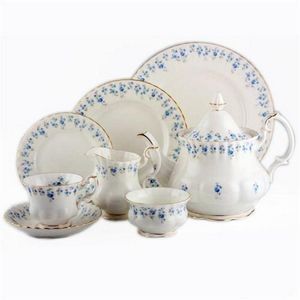George Jones Abbey Dinner Service and Accessories
You must be a subscriber, and be logged in to view price and dealer details.
Subscribe Now to view actual auction price for this item
When you subscribe, you have the option of setting the currency in which to display prices to $Au, $US, $NZ or Stg.
- Circa - A Latin term meaning 'about', often used in the antique trade to give an approximate date for the piece, usually considered to be five years on either side of the circa year. Thus, circa 1900 means the piece was made about 1900, probably between 1895 and 1905. The expression is sometimes abbreviated to c.1900.
- Ironstone China - Credit for the invention of ironstone china is generally accorded to Charles Mason in 1813. Charles Mason was one of the two sons of Miles Mason who founded the Mason works in 1802, and ran the business with his brother George Mason.
Ironstone was a heavy hard earthenware which was slightly translucent, its strength supposedly coming from a very small quantity of iron slag added to the mixture. The additional strength enabled the company to make larger objects that were not susceptible to breakage.
The company manufactured dinner wares, toilet sets, tureens, jugs and so on, and the most popular patterns were blue and white, floral and Oriental Imari style colours.
The trade name "Patent Ironstone China" was registered by the company in 1813, but the patent was only valid for 14 years and was not renewed, enabling other potteries to use the word "ironstone" in describing their wares.
Mason wares are generally well marked with "Mason's Patent Ironstone China" . - Transfer Printed / Decorated Transferware - Transfer printing is method of decorating ceramics, reducing the cost of decoration when compared to employing artists to paint each piece. A print was taken on transfer-paper from an engraved copperplate, covered in ink prepared with metallic oxides, and the image on the paper was then applied to the biscuit-fired ceramic body. The print was fixed by heating the object in an oven, and then glazed, sealing the picture. Early transfer prints were blue and white, as cobalt was the only colour to stand firing without blurring. Early in the 19th century advances in the composition of the transfer paper resulted in better definition and detail, and enabled engravers to combine line-engraving with stipple.
This item has been included into following indexes:
Visually similar items

A collection of blue and white dinner ware, including tea bowls, saucers, plates, tureen, platter and various others, approximately 45 pieces

A forty five piece Minton 'Shalimar' service plus two antique Copeland Spode 'Mandarin' bowls with plated covers, circa 1974 (Minton) and probably later 19th century (Spode), pattern 1372. Aservice for eight comprising: dinner, entree, side plates, cups an

Forty pieces Crown Derby tableware. All Derby Posies pattern, including 5 salt & pepper, tea strainer, 2 cream jugs, 3 jam dishes, sugar bowl, 2 soup dishes & saucers, creamer & sugar bowl, cake plate, 3 dinner plates, footed bowl, 5 soup bowls, & 5 sweet

Royal Albert 'Memory Lane' dinner setting comprising a teapot, coffee pot, ten dinner plates, nine side plates, ten dessert bowls, fifteen cup saucer plate sets, three soup cupe & saucers, six coffee cups & saucers, six egg cups, two salt shakers, two pepp
